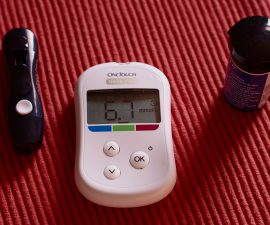Complications
Although diabetes insipidus is not categorized as the deadly disease like diabetes mellitus, you must keep paying attention when you find the symptoms indicating the disease. If not, the disease will lead you to some serious complications causing you more serious actions. Some complications caused by this diabetes include:
Dehydration
Dehydration is the first common complication caused by diabetes insipidus. In this complication, your body will find it hard to retain enough water although you drink much constantly. When your body has a lack of water inside, it means that you are experiencing dehydration. It includes the dry mouth, the thirst, the tiredness and the changes in skin elasticity. Other signs indicating dehydration are dizziness when you stand up, a headache and sunken features in the eyes as well as feeling confused or irritated.
Treating dehydration can be carried out by rebalancing the amount of water in your body. In this case, you may need an intravenous fluid replacement you can derive in the hospital. In this case, the fluids are given directly through a drip into your vein. That is the fastest way to provide your body with sufficient fluids so that you can heal the dehydration.
Electrolyte Imbalance
The second complication caused by diabetes insipidus is the electrolyte imbalance. Electrolyte is the minerals found in your blood. Electrolyte has a very small electric charge like sodium, potassium, calcium, chlorine, magnesium and bicarbonate.
if you are experiencing dehydration or losing too much water, this electrolyte will raise due to the severe lack of water. The raising electrolytes causes the body functions work improperly so that you may have a headache, fatigue, irritability and muscle pain. All of these discomfort feelings which we may call complications are caused by the electrolyte imbalance. Thus, to keep the electrolyte balance, you must make sure that your body has enough fluid or water.
Treatments or Medications
After finding out the types, the symptoms and the causes of diabetes insipidus as well as the complications that may be led by the disease, now it’s time for you to find out more information which is very crucial. It is how to treat the disease. The treatment or medication for this type of disease is much depending on the type of diabetes insipidus. Since there are two types of this diabetes, the explanation will also be divided based on the types of the disease. Check out the following sessions:
Treatment or medication for cranial
Cranial diabetes insipidus may not need any treatment or medication. All the things to do is trying to ease your symptoms by consuming or drinking more water so that you can avoid dehydration. If you routinely consult to the hormone specialist, he will suggest you to drink certain amount of water every single day. Typically, 2.5 litres each day is good.
However, if the disease is more severe, drinking water only is not enough to let you go out from dehydration. In this case, treatment prescription such as “desmopressin” is quite necessary.
Desmopressin is a powerful AVP and it is more resistant to break down than your own AVP you have in the body. It works naturally like the natural AVP which helps you to stop the kidney producing urine while you have low level of water in your body.
Desmopressin can be consumed as a nasal spray in tablet form melting in your mouth particularly between your lip and gum. For treating, you just need to spray the nasal inside your nose once or twice a day. Later, it will be absorbed throughout the bloodstream.
On the other hand, if you are prescribed desmopressin as tablets, you need to take them about three times a day. Based on the hormone specialist, it is suggested that you use tablets instead of nasal spray when you have cold. In short, desmopressin is very safe for human health. However, there are always some effects that you will feel such as headache, stomachache, feeling sick and runny nose as well as nose bleed.
If you are prescribed to use this treatment, it would be better for you not to take more because it can cause you terrible dizziness, vomiting and nausea.
Treatment or medication for nephrogenic
Now we are going to explain the treatment or medication you have to join if you are suffering nephrogenic insipidus. Nephrogenic can be the best alterative you can use after your existing treatment, particularly if you have nephrogenic diabetes insipidus caused by certain medication.
Since nephrogenic is caused by the kidney which is not responding to AVP, you can’t take desmopressin. The specialist will suggest you the followings:
- Reduce the amount of salt and protein contained in your diet. This will lead your kidney to produce less urine. Thus, what you should do here is to consume a diet with less salt and protein such as meat, eggs and nuts. Remember, do not do this without consulting to your specialist.
- Reduce the rate that the kidney filters blood. This way, you are using thiazide diuretics. Using this treatment will allow you to reduce the amount of urine passed out of the body over time. Taking this treatment will let you experience dizzy when you are standing, indigestion, very sensitive skin and erectile dysfunction in men.
- Reduce urine volume using non-steroidal anti-inflammatory drugs (NSAIDs) like ibupofren. However, there is a bad effect when you use NSAIDs for a long period that is stomach ulcer development. To avoid it, the specialist will give you a proton pump inhibitor to help you reduce the risk of ulcers forming.
Prevention
When you have been diagnosed of having diabetes insipidus, knowing the prevention is as important as knowing the treatment. Sadly, it is best described that there is never a proper method to prevent this type of disease.
However, not knowing how to prevent the disease doesn’t mean that you can’t do nothing to minimize the risk of the disease. At least, you can do several things that reduces the risk of having diabetes insipidus. We can relate the causes as well as the treatment to find out what we can do to prevent the disease attacking our body more.
In this case, when you are not diagnosed of diabetes insipidus yet, you can manage the way of consuming food and your physical activities. Check out the following suggestions which are formulated to help you reduce the risk.
Reduce the salt and protein contained in your daily diet.
Even you aren’t suffering from this kind of disease, it would be better to control the use of salt and protein in your diet. Try to reduce the use of salt as well as protein when you are cooking food. To substitute, you can still add enough vitamin through the vegetables. They are noticeably healthy for human body.
Drink 2.5 litres a day
Drinking plain water or mineral water is also very good for health. Water will help you excrete the body waste. In this case, it is suggested that you drink 2.5 litters water each day.
Have regular exercise
Diabetes insipidus as well as other disease can actually well-treated by having regular exercise. This way, having regular exercise will help you to some of the body waste through sweating.
Have regular health check
This one is the most recommended way to control your health. Through the regular health check, you will be able to know whether or not you have diabetes insipidus in your body.
Conclusion
Overall, diabetes insipidus is different from diabetes mellitus that you have commonly known. Diabetes insipidus is caused how your kidney works. You can find all about the disease including the types, the symptoms, the causes, the complications, the treatment and the prevention in this review. So, don’t hesitate to open this site again whenever you need to.




